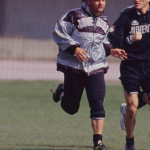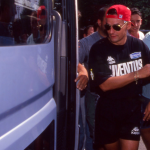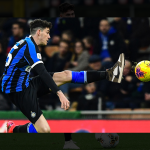
Dress like Roberto Baggio
The unrivaled style of the Divin Codino
May 26th, 2021
It was May 16, 2004 when Roberto Baggio was playing his last match in a packed San Siro. From the Rossoneri curve - which Baggio praised from '95 to '97 - a banner appeared that made history: "Dio esiste… e ha il codino". The Divin Codino will be the protagonist of the homonymous series to be released in the next few hours produced by Netflix and directed by Letizia Lamartire, with one of the best # 10 in the history of Italian football played by Andrea Arcangeli.
The biopic on Caldogno's talent will tell the ups and downs of an unrepeatable career - for better or for worse - but will focus above all on the man whose personal history has often been underestimated to understand Baggio's relationship with football. In addition to wearing the number 10 shirt in a unique way, the former Inter, Milan and Juve was a stylistic icon on and off the pitch. At the turn of the eighties and nineties, Baggio represented a personal aesthetic that is still considered unparalleled due to the way in which the Divin Codino wore the most disparate outfits. Exactly like success on the pitch, Baggio's stylistic career also had high peaks - as in the case of the USA94 World Cup - and moments of downturn - such as the 1993 Ballon d'Or ceremony. But if on the one hand everyone would like to have the feet by Roby Baggio, on the other hand there are those who would like to have the style that has the most famous pigtail in the world.
Formal for special occasions
The Paris event for the delivery of the 1993 Golden Ball could have been an excellent opportunity to show the Made in Italy style that the world envies us, but Baggio did not live up to his role as ambassador of Italian style . The red tie with a huge knot as long as the pigtail is just one example of a slightly distorted 90s aesthetic. The fit of the clothes must be contextualized with the period, while the tuxedo definitely saves the style that Roby chooses for important occasions.
Casual (chic?)
From formal clothes to a casual style that is certainly closer to the inspiration and creativity of one of the best Italian players ever. The addition of components and chic elements has often led Baggio into a little explored dimension, especially if contextualized in the era in which he dressed in this: a world without social networks, without an exorbitant number of cameras in which one lived almost only by contact direct with people. From the Persol back then to the Marcelo Burlon sweaters of now, an evolution that is difficult to explain and above all to understand if you don't live in the same way as Roberto Baggio.
Baggio Rambo
Unique style off the pitch begins with being on the pitch. It is inevitable to think of the summer of 1994, a memory that has tormented Baggio for years and that for Italians will always remain an open wound. The final lost against Brazil is not only a football moment but also a moment in which the Italian style is contaminated by elements typical of American aesthetics. When Baggio reunites with Juventus after his experience in the USA, his style changes and already at the Bianconeri retirement at the Divin Codino a band, often enormous, is added to contain the hair. And what's more American in the 90s than Rambo's style?
Sportswear & more
The Michael Jordan pose on the green is another American legacy, but the result is still not the same. Roby Baggio's sport outfits are perhaps the best story of the footballer he was and of the style icon who became consecrated in the nineties. The way of wearing Juve's Kappa jackets, reverse hats, baggy sweaters and high shorts make him immortal not only from a football point of view but also from an aesthetic point of view.
Street Baggio
Nothing, however, is comparable to Roberto Baggio's street style. The formal tells the important occasions, the casual the worldly and official occasions with the teams he played for, the American style the sporting adventures and not that he lived at the height of his career, the sportswear from which world he comes, but none style best represents the genius and creativity of a player who did with his feet what Pirandello did with his pen. A cut above all others, on and especially off the pitch.






























































































